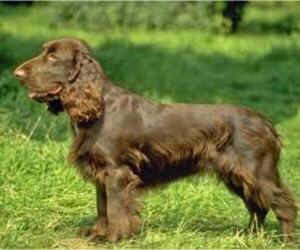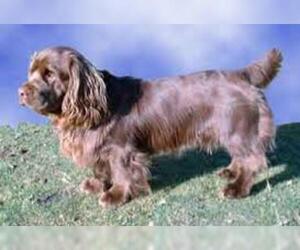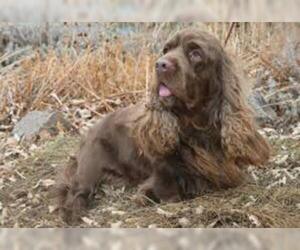
All about Sussex Spaniel dog breed
A.K.A. :Sussex, Sus, Suss, Sussex Springer, Sussex Spaniel Springer, English Sussex Spaniel, Low-Slung Spaniel, Merry Spaniel, Sussex Retriever
Size
Grooming requirements
Exercise requirements
Good with other dogs
Watchdog ability
Energetic
Training requirements
Playful
Affectionate
Good with other pets
Good with children
Good with strangers
Winter
Summer
Healthiness
Protective
Life Span
| Pure Breeds | Member |
| Breeds A - Z | S |
| Breeds by Group | Gun Dog Sporting |
| Breeds by Trait | Good With Kids Low Shedding |
| Overview: | The Sussex Spaniel is a charming and distinctive gundog, originating in Sussex, England, in the early 19th century. Known for its rich, golden-liver coat and powerful build, this medium-sized spaniel boasts a long, low body, a broad skull, and those famously soulful, drooping ears. Temperamentally, they are often described as calm and amiable, displaying a cheerful and affectionate disposition with their families. While they possess a working dog's drive and enjoy moderate exercise, their less frantic energy levels compared to some other spaniels can make them surprisingly adaptable. They generally get along well with children and other pets, making them a good fit for families, though apartment living might require diligent exercise and mental stimulation. Owners should be aware of potential breed-specific health concerns like hip and elbow dysplasia, and ear infections due to their long, pendulous ears. Overall, the Sussex Spaniel is a loyal and devoted companion for those seeking a unique and loving canine. |
F.A.Q.
All You Need to Know About the Sussex Spaniel Breed
The Sussex Spaniel is a charming, medium-sized dog, originating from Sussex, England, bred primarily for flushing game. Known for their distinctive low-slung, rectangular build, rich golden-liver coat, and soulful expression, they are truly unique. Temperamentally, they are generally calm, devoted, and friendly, though they can be a bit reserved with strangers initially. Their patient and gentle nature makes them excellent family dogs, typically getting along well with children and other pets. While adaptable, their moderate exercise needs mean daily walks and playtime are essential; they are not ideally suited for small apartment living without consistent outdoor activity. Grooming is relatively straightforward, requiring regular brushing to prevent matting of their dense coat, especially during shedding seasons. Potential owners should be aware of common health considerations such as hip and elbow dysplasia and heart conditions, making responsible breeding and veterinary check-ups crucial for a healthy Sussex Spaniel. If you're seeking a loyal, affectionate, and somewhat laid-back companion with a distinctive look, the Sussex Spaniel might be your perfect match.Sussex Spaniel Weight: Average Size & Healthy RangeThe average weight for an adult Sussex Spaniel is typically between 35-45 pounds.* Males: Generally weigh 40-45 pounds.* Females: Tend to be slightly lighter, weighing 35-40 pounds.This range represents a healthy weight for Sussex Spaniel adults. Potential owners should note that proper nutrition and exercise are key to maintaining their Sussex Spaniel's weight within this breed-standard range.
Wondering, "how tall is a Sussex Spaniel?" or what the average height of a Sussex Spaniel is? You've come to the right place!
The typical Sussex Spaniel height for an adult, measured at the shoulder (or withers), falls within a relatively consistent range. Generally, a Sussex Spaniel stands between 13 to 15 inches tall (approximately 33 to 38 cm).While individual genetics can always play a minor role, there isn't a significant difference in Sussex Spaniel average size based on gender. Both male and female Sussex Spaniels tend to fall within this 13-15 inch range, making them a moderately sized dog. This consistent stature contributes to their sturdy, low-to-ground appearance, which is a hallmark of the breed.So, when considering a Sussex Spaniel, you can expect a dog with a manageable and robust physique, perfectly suited for an active family life!The Sussex Spaniel exclusively comes in a rich golden liver color, also described as a golden auburn or dark golden liver. This is the only AKC recognized Sussex Spaniel color and is characteristic of the breed. There are no other officially recognized Sussex Spaniel colors, such as brindle, fawn, cream, or white. Rare coat types like blue, lilac, merle, or chocolate are not found in the Sussex Spaniel breed and would indicate a mixed breed, not a purebred Sussex. When searching for Sussex Spaniel colors, remember that the distinctive golden liver is the hallmark of this breed, and any other color is not an accepted variation. Potential adopters should be wary of any claims of exotic Sussex Spaniel variations as they are not purebred and would not be eligible for AKC registration.
Sussex Spaniel Personality & TemperamentThe Sussex Spaniel is a charming and loyal companion known for its gentle, yet determined nature. This breed typically displays a friendly and amiable disposition, making them excellent family pets. They are generally sociable and enjoy being part of the household, often forming strong bonds with their owners. While not overly demanding, they thrive on companionship and can be prone to separation anxiety if left alone for extended periods.Their adaptability is moderate; while they can adjust to apartment living, a house with a yard is preferable to allow for their moderate exercise needs. They are relatively calm indoors but do require daily walks or playtime to keep them happy and healthy.Regarding children, Sussex Spaniels are generally good-natured and patient, making them suitable companions for well-behaved children. However, as with all breeds, supervision is recommended, especially with very young children. Their behavior with other pets, particularly other dogs, is usually amicable, especially if socialized from a young age. They tend to get along well with other household animals, though their hunting instinct might occasionally surface with smaller, fast-moving critters, so introductions should be handled carefully. Overall, the Sussex Spaniel offers a sweet, devoted, and moderately active temperament that brings joy to many homes.
The Sussex Spaniel temperament is generally friendly, sociable, and loyal, making them excellent companion dogs. They are known for their gentle and affectionate nature with their families. While adaptable, their moderate energy and need for space make them better suited for homes with a yard rather than apartment living, though they can adjust with sufficient exercise. They typically exhibit patience and kindness with children and generally get along well with other pets when properly socialized. They can display a stubborn streak at times, requiring consistent, positive training. Despite this, their desire to please usually outweighs their occasional willfulness. They are also quite sensitive and respond best to calm, encouraging methods rather than harsh correction. Potential adopters will find them to be devoted and charming companions.
Sussex Spaniel Care: Daily Maintenance & Health TipsCaring for a Sussex Spaniel is rewarding, focusing on their unique needs. Sussex Spaniel care involves moderate grooming, controlled exercise, and specific health considerations. Their beautiful, silky coat requires weekly brushing to prevent mats and minimize shedding, with more frequent attention during shedding season. Occasional professional grooming may be beneficial. Despite their sturdy appearance, Sussex Spaniels are a low-energy dog breed. They need daily, moderate exercise – a good walk or supervised playtime in a secure yard is usually sufficient. Avoid strenuous activity, especially in warm weather, due to their brachycephalic (short-nosed) anatomy, which makes them susceptible to overheating. How to care for a Sussex Spaniel also includes careful dietary management; they can be prone to weight gain, so a high-quality, balanced diet in appropriate portions is crucial for weight management. Regular wrinkle and ear cleaning is essential to prevent infections in their folds and long, pendulous ears. Use a vet-approved cleaner and dry thoroughly. Their brachycephalic nature also means climate sensitivity; always ensure they are cool in summer and protected from extreme cold. Common health tips for Sussex Spaniel include regular vet check-ups to monitor for potential issues like skin issues (especially in their folds), patellar luxation, hip and elbow dysplasia, and eye conditions. Consistent dental care with daily brushing is vital to prevent periodontal disease. Proactive care ensures your Sussex Spaniel lives a long, healthy, and happy life.
Sussex Spaniel Activity Level: Moderate to LowThe Sussex Spaniel activity level is best described as moderate to low, making them an excellent fit for various households. They are not high-energy dogs, balancing short bursts of playful energy with long periods of rest and relaxation.Typical Energy Levels: Sussex Spaniels typically exhibit a calm and somewhat sedate demeanor indoors. They enjoy a good nap on the sofa but are always ready for a short outdoor adventure. Their energy is generally a gentle, sustained hum rather than an explosive, constant drive.Daily Exercise Needs: To maintain their physical and mental well-being, Sussex Spaniels require approximately 30-60 minutes of daily exercise. This can be divided into a couple of shorter walks or a single longer stroll. They are not built for extensive running or strenuous activities. Leashed walks in a park, a romp in a securely fenced yard, or a game of fetch are ideal.Playtime Preferences: While not excessively boisterous, Sussex Spaniels do enjoy playtime. They appreciate interactive games with their owners, especially those involving scent work or retrieving. Toys that squeak or can be carried are often favorites. They are generally gentle players and are not prone to roughhousing.Limitations Due to Brachycephalic Anatomy: Due to their brachycephalic (short-nosed) anatomy, Sussex Spaniels are sensitive to heat and strenuous exercise, especially in warm or humid weather. Their airways are less efficient, making it difficult for them to cool down. It is crucial to avoid over-exertion, particularly during hot periods, and to always provide access to fresh water and shade. Monitor them closely for any signs of overheating, such as excessive panting or lethargy.Suitability for Families: How active are Sussex Spaniel? They are suitable for both low-energy households and families seeking a moderately active companion. They can adapt well to apartment living as long as their daily exercise needs are met. While they enjoy being part of family activities, they are not dogs that require constant engagement or hours of intense play. They are excellent companions for individuals or families who appreciate a calm, affectionate, and moderately active canine friend. They thrive on companionship and being involved in the daily rhythms of their home, even if that involves a lot of napping on the couch next to their loved ones.
Sussex Spaniels are not brachycephalic, so brachycephalic dog care practices are unnecessary. However, their heavy build and dense coat contribute to heat sensitivity, especially in warm climates or during vigorous activity. Providing shade, hydration, and rest breaks is essential. Spinal problems such as IVDD and arthritis may be exacerbated by jumping or rough play, so controlled exercise and weight management are key.
Understanding how to keep Sussex Spaniel healthy involves regular veterinary checkups, early screening for joint, metabolic, and cardiac conditions, consistent grooming to manage coat and ear hygiene, weight control, and tailored exercise routines. With attentive care, Sussex Spaniels can enjoy a gentle, affectionate life of 13–15 years.
Breed Breakdown: What Experts Say About the Sussex Spaniel
The Sussex Spaniel, characterized by its sturdy and low-set build, receives a rating of 6 for its "Size" trait. While not a giant, it's also far from diminutive. Weighing typically between 35 and 45 pounds and standing around 13 to 15 inches tall at the shoulder, the Sussex possesses a substantial bone structure and a somewhat elongated body. This places it firmly in the medium-sized category when compared to the vast spectrum of companion dogs, being noticeably larger than many toy breeds like Chihuahuas or even smaller terriers, yet significantly smaller than breeds such as Great Danes or Mastiffs. Its stocky build and moderate dimensions make it a good fit for households with a bit of space, but it's generally not ideal for very small apartment living without consistent outdoor exercise. Its size is manageable for travel in a crate designed for a medium-sized dog, but it won't easily fit under an airplane seat. For households with moderate space constraints, a Sussex Spaniel could work, but it certainly isn't a "lap dog" in the tiny sense, preferring to stretch out on its own.
I would rate the Sussex Spaniel's grooming requirements as a 6.While not extremely high-maintenance like a Poodle or an Afghan Hound, they certainly aren't a wash-and-go breed. Their long, dense, and soft coat, characteristic of a spaniel, sheds moderately year-round and requires regular brushing – at least 2-3 times a week, and more frequently during shedding seasons – to prevent mats and tangles, particularly in the feathering on their legs, chest, and tail. Their long, pendulous ears are prone to infections if not cleaned regularly (weekly) and kept dry, making ear care a significant consideration. Nail trimming is essential, as with all dogs, and their tendency to gain weight can sometimes lead to slight skin folds that need monitoring, though this isn't a prominent breed feature like in a Bulldog. They don't have excessively oily coats, so bathing every 4-6 weeks or as needed should suffice, but proper drying to prevent skin issues under their thick coat is important. Compared to many companion dogs, they require a consistent grooming routine to maintain their coat and prevent common spaniel issues, pushing them into the moderately high category rather than easy-care.
I would rate the Sussex Spaniel's "Exercise Requirements" as a 4 out of 10.The Sussex Spaniel, while a sporting breed, possesses a distinctly lower energy level compared to many of its spaniel cousins. They are generally content with a moderate amount of daily activity, thriving on regular, leashed walks of 30-60 minutes per day, perhaps broken into two sessions. Their stocky build and brachycephalic (short-nosed) anatomy mean they are not built for extensive, sustained running or high-impact activities. They can easily overheat in warm weather and may experience respiratory distress if over-exercised. While they enjoy playtime and exploring scents in a secure yard, they aren't typically "go-go-go" dogs that demand hours of intense exercise. Structured routines focused on sniffing games, short training sessions, and moderate walks are sufficient to keep them healthy and mentally stimulated, preventing boredom without requiring a marathon runner as an owner. They are more likely to enjoy a comfortable nap on the sofa after a good walk than demand another vigorous outing.
I would rate the Sussex Spaniel's "Watchdog Ability" as a 3 out of 10.While not entirely oblivious, the Sussex Spaniel is far more of a passive companion than a vigilant protector. They are generally good-natured and friendly, with a relatively low level of natural suspicion towards strangers. Their barking behavior tends to be moderate; they might bark to express excitement or a desire for attention, rather than as an alarm signal. Territorial instincts are not strong, and they are unlikely to perceive an unfamiliar person as a threat unless that person directly threatens their immediate family. They might offer a single, low bark or a curious glance at an unfamiliar sound, but they are highly unlikely to escalate this into sustained warning barks or show any real willingness to deter an intruder. They are more likely to greet a new person with a wagging tail or a request for a scratch than to sound a serious alarm. While they might provide a very subtle, fleeting "early warning" in the form of a brief bark at the doorbell, it would be inaccurate to describe them as capable of providing meaningful, sustained deterrence in a home environment.
I would rate the "Good with Other Dogs" trait of the Sussex Spaniel an 8 out of 10.Sussex Spaniels are generally known for their placid and agreeable temperament, which extends to their interactions with other canines. They are typically not prone to aggression or dominance and tend to be quite amiable with unfamiliar dogs, often approaching with a gentle curiosity rather than challenging behavior. Their moderate energy level and sturdy build make them compatible with a range of dog sizes and energy levels, though they might be overwhelmed by very boisterous breeds without proper introductions. While they certainly benefit from early socialization to refine their manners, they don't usually require extensive, specialized training to coexist peacefully in a multi-dog household. In fact, many Sussex Spaniels thrive in canine company, enjoying the companionship and often seeking out playful interaction. They are adaptable and can integrate well into multi-dog environments, often becoming quite bonded with their doggy companions. Careful introductions are always advisable with any new dog, but with Sussex Spaniels, these are typically straightforward and lead to a harmonious relationship.
I would rate the "Energetic" trait of the Sussex Spaniel as a 4.Sussex Spaniels are generally more laid-back and less intensely energetic than many other sporting breeds or active companion dogs. While they are certainly not couch potatoes and enjoy a good walk and a playful session, their activity level is moderate. They have decent endurance for a walk in the park or a moderate hike, but they aren't typically described as tireless. Their playfulness is present, often in bursts, but they are also quite content to relax by their owner's side. Their need for physical stimulation is present but not overwhelming; daily walks and some interactive play are usually sufficient.A significant factor influencing their stamina and exercise tolerance is their brachycephalic (short-nosed) anatomy. This can make them more prone to overheating and respiratory difficulties during strenuous or prolonged exercise, especially in warm weather. This physical limitation naturally caps their ability to participate in high-intensity outdoor or athletic activities compared to a dolichocephalic (long-nosed) breed of similar size. They are much more likely to be satisfied with a leisurely ramble than a marathon run, and their owners need to be mindful of their breathing and temperature regulation during any physical activity.
I'd rate the Sussex Spaniel's "Training Requirements" a 7.While intelligent and capable of learning, Sussex Spaniels possess a notable independent streak and a strong scent drive that can make them less immediately responsive to commands than some other breeds. Their stubbornness can be a significant factor, requiring a high degree of patience and consistency from their owner. They have a good attention span for engaging activities, but can quickly lose focus if training becomes repetitive or if a more interesting scent or sight presents itself. Positive reinforcement is highly effective, as they are food-motivated and eager to please *when they choose to be*, but harsh methods will backfire and make them retreat. This breed is not particularly beginner-friendly; their training requires an experienced handler who understands spaniel temperament and is prepared to invest time in structured, varied routines and consistent reinforcement to overcome their inherent willfulness and capitalize on their intelligence.
I would rate the Sussex Spaniel's "Playful" trait a 6 out of 10. While not as overtly boisterous or hyperactive as some other sporting breeds, the Sussex does possess a delightful and engaging playful side. They enjoy games and interaction, particularly with their beloved family, and will readily engage with toys and a good romp. Their activity level is moderate; they appreciate daily walks and a chance to stretch their legs and play, but aren't typically bouncing off the walls. They do show affection and will seek attention, often with a charming, tail-wagging enthusiasm. Compared to more high-energy companion dogs, they are definitely more laid-back, preferring a comfortable spot on the sofa after a good play session rather than constant activity. However, they are far from inactive or purely sedate, displaying a good-natured and enthusiastic interest in their surroundings and the fun to be had.
I would rate the Affectionate trait of the Sussex Spaniel at a strong 9.The Sussex Spaniel is renowned for its deeply devoted and loving nature. They thrive on human companionship, often displaying a strong desire to be physically close to their owners. Cuddling, lap-sitting (despite their sturdy build), and leaning are common behaviors. Their loyalty is unwavering, forming strong bonds with their family members and often exhibiting a sensitivity to their owners' emotions, seeking to comfort or engage. They have a distinct "shadow" quality, frequently following their family members from room to room, preferring to be in the same space. Compared to many companion dogs, they are not independent; they genuinely thrive on affection and attention, making them incredibly loving and people-oriented companions.
I would rate the "Good with Other Pets" trait of the Sussex Spaniel an 8 out of 10.The Sussex Spaniel is generally a highly amicable and adaptable breed, particularly known for its laid-back and good-natured temperament. They are typically quite sociable with other dogs, often enjoying their company due to their pack animal instincts as a flushing spaniel. While they do possess a moderate prey drive characteristic of a hunting breed, it's usually directed towards game and less so towards household pets, especially if introduced early and socialized appropriately. They can learn to coexist peacefully with cats, particularly if raised together from a young age, often viewing them as part of their "pack." Resource guarding tendencies are typically low in the breed, though individual personalities can vary, and proper training and management are always beneficial. Their adaptability makes them well-suited for multi-pet households, and while early socialization is always recommended for any dog to ensure the best possible outcomes, the Sussex Spaniel's naturally friendly disposition means they often require less intensive intervention than some other breeds to peacefully integrate with other animals. Supervision is always wise in any multi-pet environment, but the Sussex generally leans towards peaceful coexistence rather than conflict.
The Sussex Spaniel rates a 7 out of 10 for "Good with Children."This breed is generally known for its placid and affectionate nature, making them a good fit for families. Their calm demeanor and patience are admirable, and they are not typically high-strung, which contributes to their tolerance of the unpredictable nature of children. They can be playful, enjoying a gentle romp in the yard, but they aren't overly boisterous or prone to roughhousing in a way that might overwhelm younger kids. They are also quite devoted to their families and tend to be naturally gentle, rather than requiring extensive training just to be tolerant.However, the "7" rather than a higher score reflects a few nuances. While generally tolerant of noise and handling, very young children who haven't learned to be gentle could potentially test their patience, as with any dog. They are also not as overtly playful and energetic as some other family breeds, so they might not be the ideal playmate for extremely active, older children who want a dog to run for hours with. Supervision, as with all dog-child interactions, is always recommended, but the Sussex Spaniel's inherent calm and affectionate disposition makes them a genuinely good and relatively low-maintenance choice for families with children of various ages, especially those who appreciate a more relaxed and gentle canine companion.
The Sussex Spaniel, regarding its "Good with Strangers" trait, rates a solid 6.While not inherently aggressive or unfriendly, the Sussex Spaniel tends to be somewhat reserved and, at times, wary of unfamiliar adults. They are generally not the type to exuberantly greet every new person they encounter, and their initial reaction might be to observe from a distance rather than rush in for pets. This can manifest as a quiet shyness, though they are rarely truly fearful. With proper socialization from a young age, they can become accepting and polite, but they are not naturally effusive. They are not typically prone to excessive barking or guarding behavior towards strangers; their caution is more rooted in a discerning nature. Their adaptability in public or guest-filled environments depends heavily on their individual temperament and early exposure, and they often prefer the company of their trusted family. While they can be trained to be comfortable and well-mannered around strangers, they are not naturally outgoing and will likely remain more reserved than some other spaniel breeds.
I'd rate the Sussex Spaniel's "Winter" tolerance at a 5. While they possess a dense, weather-resistant double coat and a sturdy build, offering some insulation, their relatively moderate size means they lose heat more quickly than very large breeds. Their brachycephalic (short-nosed) anatomy is a significant concern, as it compromises their ability to efficiently warm inhaled air, increasing the risk of respiratory issues and making them more susceptible to cold-induced stress, especially during strenuous activity. Furthermore, despite their solid appearance, they aren't inherently built with the substantial subcutaneous fat reserves of, say, a northern breed. They can certainly enjoy outdoor activities in cold climates, but require significant consideration. Compared to other companion dogs, the Sussex Spaniel absolutely requires special care in winter, primarily due to their brachycephalic nature. Short-duration outings are best, and owners must be vigilant for signs of discomfort or labored breathing. A warm, dry indoor environment is crucial, and they should never be left outside for extended periods in freezing temperatures. They might even benefit from a coat for prolonged walks in very cold, windy, or wet conditions to prevent hypothermia.
Rating: 3The Sussex Spaniel, due to its moderately brachycephalic (short-nosed) anatomy, dense coat, and somewhat stocky build, has a significantly reduced ability to regulate its body temperature effectively in hot weather. Their shorter snouts restrict efficient panting, which is a dog's primary cooling mechanism, making them highly susceptible to overheating and heatstroke. Even moderate exercise on warm days can be dangerous, and strenuous activity is strongly discouraged in anything but very mild temperatures.Compared to many other companion dog breeds, Sussex Spaniels require substantial special care in summer months. They should be kept indoors in air-conditioned environments during the hottest parts of the day and only allowed outside for short, supervised potty breaks in the early morning or late evening when temperatures are cooler. Access to shade, fresh water, and cooling mats is essential. Owners must be vigilant for any signs of heat stress, as heatstroke can rapidly become life-threatening. This breed is not suited to hot climates without significant environmental modifications and a highly cautious approach to summer activities.
I would rate the Sussex Spaniel's "Healthiness" trait as a 6 out of 10.While generally a robust and sturdy breed, the Sussex Spaniel does have some genetic predispositions that prevent a higher rating. They are known to be prone to certain orthopedic issues, particularly hip and elbow dysplasia, which can lead to lameness and pain. Eye conditions such as progressive retinal atrophy (PRA) and entropion can also occur. Like many deep-chested breeds, bloat (gastric dilatation-volvulus) is a concern, and ear infections are common due to their pendulous ears. Their relatively short lifespan for a medium-sized dog (around 10-12 years) also brings the score down slightly. However, responsible breeding practices and health screening for these conditions can significantly mitigate the risk. They are not typically considered high-maintenance in terms of health issues compared to some brachycephalic or giant breeds, but they do require consistent preventive care, including ear cleaning and monitoring for signs of joint or eye problems. Overall, they are generally robust but not without their breed-specific vulnerabilities.
I would rate the "Protective" trait of the Sussex Spaniel as a 3 out of 10.While their loyalty to owners is undeniable and they possess a certain level of alertness, these qualities translate more into being an excellent companion than a protective force. Sussex Spaniels are generally good-natured and friendly, even towards strangers, which diminishes their effectiveness as a guard dog. They might bark to alert you to an unfamiliar presence, making them a rudimentary "doorbell," but their gentle disposition means they are highly unlikely to act aggressively or offer meaningful physical protection in a household setting. They are primarily bred as gentle, calm hunting companions and affectionate family members, not as deterrents or guardians.
I would rate the Sussex Spaniel's "Life Span" trait a 7 out of 10.The Sussex Spaniel is generally considered to have an average to slightly above-average lifespan for a medium-sized purebred dog. Their typical life expectancy ranges from 10 to 12 years, and often extends to 14 years with excellent care. While they are not among the exceptionally long-lived breeds, they also don't suffer from a disproportionate number of severe, early-onset health issues that dramatically shorten their lives. Common health concerns, such as hip and elbow dysplasia, eye conditions (like progressive retinal atrophy), and heart issues, are present in the breed, but responsible breeding practices, including health testing of parent dogs, help to mitigate the prevalence and severity of these genetic predispositions. Dedicated owners who provide proper nutrition, regular exercise, and consistent veterinary care can significantly contribute to their Sussex Spaniel reaching the higher end of their life expectancy, making them a fairly robust and enduring companion compared to some other breeds.
Sussex Spaniel Dogs for adoptionSee all dogs for adoption
Similar Dog Breeds for Sussex Spaniel
Quick Breed Selector 0 - not important, 1 - smallest, 10 - largest
Variants & Mistakes :Sussex Spanial, Sussexx Spaniel, Susex Spaniel, Sussec Spaniel, Sussex Espaniel, Susseks Spaniel, Sussez Spaniel, Sussx Spaniel, Susses Spaniel, Susux Spaniel, Sussexi Spaniel, Sussexs Spaniel, Sussex Spanil, Sussex Spaneil, Sussex Spanyel, Sussex Spanniel, Sussex Spanal, Sussex Spanel, Susseck Spaniel, Sussek Spaniel, Susexx Spaniel, Susset Spaniel, Susssex Spaniel, Susx Spaniel, Sussex Sapaniel, Sussex Sepaniel, Sussex Spanie, Sussex Spanl, Sussex Spaniek, Susex Spaneil, Sussetz Spaniel, Sussix Spaniel, Sussx Spaneil, Suszex Spaniel





